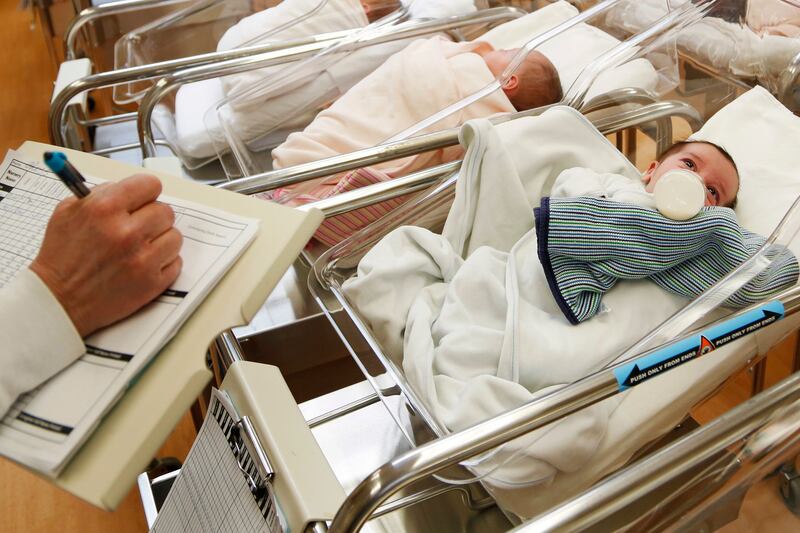SALT LAKE CITY — Americans have been feeling COVID-19’s effects in how they shop, socialize and work. But greater impacts coming to the economy may not be felt for years.
Experts say the pandemic could result in up to a half-million fewer U.S. births next year — a decline that could reverberate far into the future, changing local schools, housing markets, employment opportunities and Social Security, among other aspects of life.
Demographic Intelligence this week will release its COVID Family Survey, finding as many as 3% of American women who were thinking about having children said they would delay their plans, sometimes by a few years, while 4% say they’d like to have larger families than they’d planned pre-COVID-19.
“While a net 3% delay in childbearing may sound small, it adds up to a lot of lost births: over 100,000 missed births if the delay continues over the course of the year. That’s about as many births as will occur in Utah over two years. In other words, while more diffuse around the country, the delay we’re talking about is as if an entire state just stopped reproducing itself,” said Lyman Stone, Demographic Intelligence’s chief information officer.
Meanwhile, a new Brookings Institution report says the “COVID-19 episode will likely lead to a large, lasting baby bust.”
While birthrates bob up and down a bit, study authors Melissa S. Kearney and Phillip Levine calculate between 300,000 and 500,000 fewer births next year. They base the projection on two historical events that reduced birthrates: the recent Great Recession and the 1918 Spanish flu.
The current pandemic has elements of both, including a public health crisis and the economic turmoil of a recession likely to linger — though in 1918, World War I bolstered the economy, said Levine, an economics professor at Wellesley College.
Ramifications today include “much worse long-run outlooks for key sectors of the economy like real estate and education, as well as worse government finances,” Stone said. “But even more than these aggregate effects, this drop in births represents a huge number of women not having the family life they desire ... family dreams increasingly deferred, delayed and ultimately unfulfilled.”
Unfolding saga
Economic hardship and birthrates have long been linked. In 2014, Kearney, a Brookings senior fellow, and others found a 1.4% decrease in birthrates for each 1% increase in unemployment, for example.
The Federal Reserve predicts unemployment will be 9.3% by year’s end — down from 14.7% in April but well above the pre-COVID 3.5%.
Births were already declining, even in states like Utah with higher fertility, said Pamela S. Perlich, director of demographic research for the Kem C. Gardner Policy Institute at the University of Utah.

“The uncertainty caused by COVID 19, with the dual public health and economic crises, will certainly put additional pressure on young families,” she noted. “It is the cumulative effect of many years of declining fertility rates that really matters.”
Disparate impact
A low birthrate can have a compounding effect on the economy. In hard times, people are less likely to have children. But not having children can create hard times.
Consider the labor market. An adequate supply of employees is vital to a healthy economy. And for programs like Social Security, based on younger people paying the benefits that older people withdraw, a falling birthrate has “very dramatic implications,” Levine said.
“The economic impacts of lower fertility are so enormous, they can actually be difficult to spot,” Stone warned. “But think of people living in places with declining populations like Detroit or Appalachia: Even in economic boom times, they just can’t sell their houses for very much, because each generation is smaller than the last one. Instead of being a savings vehicle, housing ‘wealth’ becomes a liability when population declines.“
Likewise, in communities that rely on schools and universities for local employment, declining enrollment can portend economic crisis.
“The economic hurricane that has sunk so many companies producing maternity, infant and child products in recent years will soon make landfall in the educational sector, and in 15 years or so will crest over the housing market, causing a huge amount of paper wealth to evaporate,” Stone said.
Having fewer children also lessens demand for pediatricians or for services and products consumers buy for children, said Perlich. Yet fewer children can also mean more money invested in each child, she added.
Recovery isn’t as simple as finding jobs for people who lost them during COVID-19, said Levine. “You are still worse off than you were. It takes a long time — years — to return to baseline. We know that, based on evidence from past cyclical downturns. We’re talking about (a period) of very significant financial difficulties, plus years of diminished economic prosperity. None of those things are good for thinking about whether this is the right time to have a child.”
Policymakers could offset the “demographic headwinds” facing Americans by enacting family-friendly policy, Stone said. They could remove tax and welfare penalties associated with marriage, especially for working-class families. Child tax benefits could be enhanced. They could “repeal zoning rules that make housing too expensive and licensing rules that make career advancement too burdensome.” Public universities could be assessed on eventual employment rather than graduation rates.
“No one policy is a silver bullet. But American women still report desiring more than two children on average,” Stone said. “Reasons for low fertility all relate to obstacles to achieving that desire, not a systematic, cultural turn away from family.”
Correction: An earlier version misidentified the source of this quote: Ramifications today include “much worse long-run outlooks for key sectors of the economy like real estate and education, as well as worse government finances. But even more than these aggregate effects, this drop in births represents a huge number of women not having the family life they desire ... family dreams increasingly deferred, delayed and ultimately unfulfilled.” It should have been attributed to Lyman Stone, not Phillip Levine.


 alt=Lois M. Collins
alt=Lois M. Collins